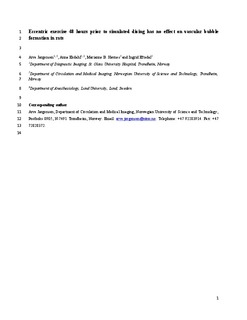Eccentric exercise 48 h prior to simulated diving has no effect on vascular bubble formation in rats
Journal article, Peer reviewed
Permanent lenke
http://hdl.handle.net/11250/2444371Utgivelsesdato
2014Metadata
Vis full innførselSamlinger
Originalversjon
European Journal of Applied Physiology. 2014, 115 (3), 597-605. 10.1007/s00421-014-3046-zSammendrag
PURPOSE: Decompression sickness (DCS) caused by vascular bubble formation is a major risk when diving. Prior studies have shown that physical exercise has a significant impact in both reducing and increasing bubble formation. There is limited knowledge about the mechanisms, but there are indications that exercise-induced muscle injury prior to diving may cause increased bubble formation. The purpose of this study was to investigate the role of exercise-induced muscle injury as a possible mechanism of bubble formation during diving. METHODS: Muscle injury was induced by exposing female Sprague-Dawley rats (n = 30) to a single bout of eccentric exercise, 100 min intermittent, downhill (-16°) treadmill running. Forty-eight hours later, the animals were exposed to a 50-min simulated saturation dive (709 kPa) in a pressure chamber, when the degree of muscle injury and inflammation would be the most pronounced. Bubble formation after the dive was observed by ultrasonic imaging for 4 h. RESULTS: No difference in bubble loads was found between the groups at any time despite evident muscle injury. Maximum bubble loads (bubbles cm-2 heart cycle-1) were not different, exercise: 1.6 ± 3.5 SD vs control: 2.2 ± 4.1 SD, P = 0.90, n = 15 in each group. CONCLUSIONS: Eccentric exercise performed 48 h prior to diving causes skeletal muscle injury but does not increase the amount of vascular bubbles in rats. The prevailing recommendation is that physical activity prior to diving is a risk factor of DCS. However, present and previous studies implicate that pre-dive physical activity does not increase the DCS risk.
